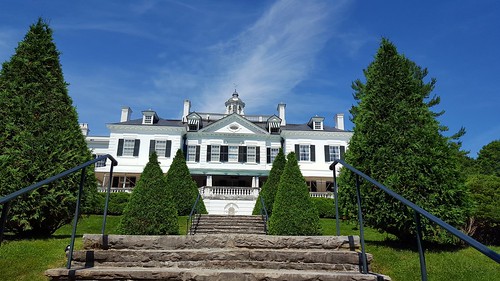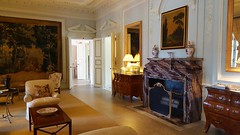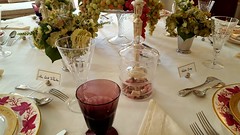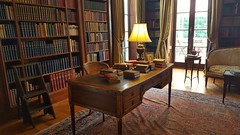I’ve never been much of an Edith Wharton fan. I read and disliked Ethan Frome as an undergrad, and I generally dislike the overwrought stuffiness of Gilded Age authors such as Henry James, who was friends with Wharton. But this past weekend I visited the Mount, Edith Wharton’s lush country home in Lenox, Massachusetts, and seeing this place where Wharton lived and wrote helped soften my attitude toward her.
Like her prose, Wharton’s house is too formal and fancy for my taste. Curatorial placards around the house insist that Wharton’s style was less ornate and more modern than the Victorian style of her contemporaries, but even Wharton’s more stripped-down decor is too busy for my taste. But after wandering through Wharton’s house and surrounding gardens, I found myself sympathizing for her. Wharton believed so strongly that interior design should reflect a person’s taste and temperament, she co-wrote a book on the subject. Although Wharton’s writing and home decor styles aren’t my cup of tea, I can understand her desire to use her house and gardens as a form of self-expression.
Both Wharton and her husband, Teddy, loved little dogs, and the Mount contains ample evidence of this one thing the couple had in common. There are dog treats on the dining room table, an ornate dog bed in the drawing room, and pictures throughout the house of Edith and Teddy with small dogs perched on their laps. Sadly, this shared affection for dogs wasn’t enough to keep Edith and Teddy Wharton together: the couple divorced and sold their home only nine years after moving to Lenox, leaving behind the house, grounds, and a beautifully sited pet cemetery overlooking the gardens.
Although I didn’t know much about Wharton’s life before touring the Mount, I’d heard stories about how she wrote. The library at the Mount contains an elegant desk where Wharton sometimes posed for portraits, but she is better known for writing in bed, tossing pages of longhand prose onto the floor where her secretary would retrieve and reorder them. Although it’s difficult to sympathize with someone so privileged she didn’t have to type much less number her own pages, I felt sad standing in Wharton’s bedroom. As light streamed through windows overlooking Wharton’s beloved gardens, I could imagine how lonely she must have felt as she lay alone writing while her marriage crumbled.
After her divorce, Wharton moved to Paris, leaving behind the house and gardens she’d designed and the pampered pets she’d buried there. Virginia Woolf famously insisted that in order to write, a woman needs a reliable income and a room of her own, and Wharton, who was born into wealth, had both, at least for a time. Ultimately, though, Wharton was forced by circumstance to leave the house she had both designed and loved, her room of her own being nothing less than the entire world.





Jul 21, 2016 at 12:42 am
an interesting life
https://en.wikipedia.org/wiki/Edith_Wharton
LikeLiked by 1 person
Jul 21, 2016 at 8:35 am
Interesting! I’ve read a few Edith Wharton books but I don’t know much about her. I wonder what was behind her breakup with Teddy? And is she related somehow to the Wharton School in Philly?
LikeLiked by 1 person
Jul 21, 2016 at 8:59 am
As far as I know, Edward (Teddy) Wharton wasn’t related to Joseph Wharton, who founded the Wharton School. Apparently mental illness ran in the Wharton family, and Teddy’s deteriorating mental state is sometimes cited as the reason his marriage failed. (That and the fact that he embezzled money from Edith to support a mistress.)
LikeLike